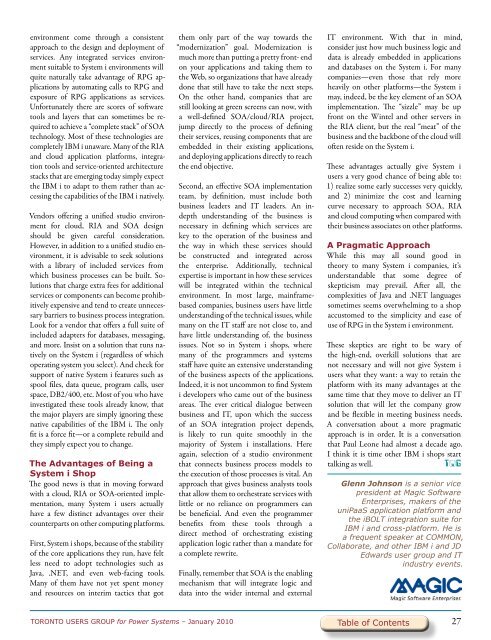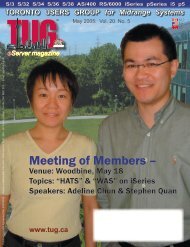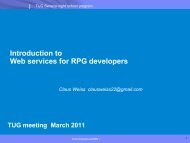Complete Magazine - PDF (5589K) - Toronto Users Group for Power ...
Complete Magazine - PDF (5589K) - Toronto Users Group for Power ...
Complete Magazine - PDF (5589K) - Toronto Users Group for Power ...
You also want an ePaper? Increase the reach of your titles
YUMPU automatically turns print PDFs into web optimized ePapers that Google loves.
environment come through a consistent<br />
approach to the design and deployment of<br />
services. Any integrated services environment<br />
suitable to System i environments will<br />
quite naturally take advantage of RPG applications<br />
by automating calls to RPG and<br />
exposure of RPG applications as services.<br />
Un<strong>for</strong>tunately there are scores of software<br />
tools and layers that can sometimes be required<br />
to achieve a “complete stack” of SOA<br />
technology. Most of these technologies are<br />
completely IBM i unaware. Many of the RIA<br />
and cloud application plat<strong>for</strong>ms, integration<br />
tools and service-oriented architecture<br />
stacks that are emerging today simply expect<br />
the IBM i to adapt to them rather than accessing<br />
the capabilities of the IBM i natively.<br />
Vendors offering a unified studio environment<br />
<strong>for</strong> cloud, RIA and SOA design<br />
should be given careful consideration.<br />
However, in addition to a unified studio environment,<br />
it is advisable to seek solutions<br />
with a library of included services from<br />
which business processes can be built. Solutions<br />
that charge extra fees <strong>for</strong> additional<br />
services or components can become prohibitively<br />
expensive and tend to create unnecessary<br />
barriers to business process integration.<br />
Look <strong>for</strong> a vendor that offers a full suite of<br />
included adapters <strong>for</strong> databases, messaging,<br />
and more. Insist on a solution that runs natively<br />
on the System i (regardless of which<br />
operating system you select). And check <strong>for</strong><br />
support of native System i features such as<br />
spool files, data queue, program calls, user<br />
space, DB2/400, etc. Most of you who have<br />
investigated these tools already know, that<br />
the major players are simply ignoring these<br />
native capabilities of the IBM i. The only<br />
fit is a <strong>for</strong>ce fit—or a complete rebuild and<br />
they simply expect you to change.<br />
The Advantages of Being a<br />
System i Shop<br />
The good news is that in moving <strong>for</strong>ward<br />
with a cloud, RIA or SOA-oriented implementation,<br />
many System i users actually<br />
have a few distinct advantages over their<br />
counterparts on other computing plat<strong>for</strong>ms.<br />
First, System i shops, because of the stability<br />
of the core applications they run, have felt<br />
less need to adopt technologies such as<br />
Java, .NET, and even web-facing tools.<br />
Many of them have not yet spent money<br />
and resources on interim tactics that got<br />
TORONTO USERS GROUP <strong>for</strong> <strong>Power</strong> Systems – January 2010<br />
them only part of the way towards the<br />
“modernization” goal. Modernization is<br />
much more than putting a pretty front- end<br />
on your applications and taking them to<br />
the Web, so organizations that have already<br />
done that still have to take the next steps.<br />
On the other hand, companies that are<br />
still looking at green screens can now, with<br />
a well-defined SOA/cloud/RIA project,<br />
jump directly to the process of defining<br />
their services, reusing components that are<br />
embedded in their existing applications,<br />
and deploying applications directly to reach<br />
the end objective.<br />
Second, an effective SOA implementation<br />
team, by definition, must include both<br />
business leaders and IT leaders. An indepth<br />
understanding of the business is<br />
necessary in defining which services are<br />
key to the operation of the business and<br />
the way in which these services should<br />
be constructed and integrated across<br />
the enterprise. Additionally, technical<br />
expertise is important in how these services<br />
will be integrated within the technical<br />
environment. In most large, mainframebased<br />
companies, business users have little<br />
understanding of the technical issues, while<br />
many on the IT staff are not close to, and<br />
have little understanding of, the business<br />
issues. Not so in System i shops, where<br />
many of the programmers and systems<br />
staff have quite an extensive understanding<br />
of the business aspects of the applications.<br />
Indeed, it is not uncommon to find System<br />
i developers who came out of the business<br />
areas. The ever critical dialogue between<br />
business and IT, upon which the success<br />
of an SOA integration project depends,<br />
is likely to run quite smoothly in the<br />
majority of System i installations. Here<br />
again, selection of a studio environment<br />
that connects business process models to<br />
the execution of those processes is vital. An<br />
approach that gives business analysts tools<br />
that allow them to orchestrate services with<br />
little or no reliance on programmers can<br />
be beneficial. And even the programmer<br />
benefits from these tools through a<br />
direct method of orchestrating existing<br />
application logic rather than a mandate <strong>for</strong><br />
a complete rewrite.<br />
Finally, remember that SOA is the enabling<br />
mechanism that will integrate logic and<br />
data into the wider internal and external<br />
IT environment. With that in mind,<br />
consider just how much business logic and<br />
data is already embedded in applications<br />
and databases on the System i. For many<br />
companies—even those that rely more<br />
heavily on other plat<strong>for</strong>ms—the System i<br />
may, indeed, be the key element of an SOA<br />
implementation. The “sizzle” may be up<br />
front on the Wintel and other servers in<br />
the RIA client, but the real “meat” of the<br />
business and the backbone of the cloud will<br />
often reside on the System i.<br />
These advantages actually give System i<br />
users a very good chance of being able to:<br />
1) realize some early successes very quickly,<br />
and 2) minimize the cost and learning<br />
curve necessary to approach SOA, RIA<br />
and cloud computing when compared with<br />
their business associates on other plat<strong>for</strong>ms.<br />
A Pragmatic Approach<br />
While this may all sound good in<br />
theory to many System i companies, it’s<br />
understandable that some degree of<br />
skepticism may prevail. After all, the<br />
complexities of Java and .NET languages<br />
sometimes seems overwhelming to a shop<br />
accustomed to the simplicity and ease of<br />
use of RPG in the System i environment.<br />
These skeptics are right to be wary of<br />
the high-end, overkill solutions that are<br />
not necessary and will not give System i<br />
users what they want: a way to retain the<br />
plat<strong>for</strong>m with its many advantages at the<br />
same time that they move to deliver an IT<br />
solution that will let the company grow<br />
and be flexible in meeting business needs.<br />
A conversation about a more pragmatic<br />
approach is in order. It is a conversation<br />
that Paul Leone had almost a decade ago.<br />
I think it is time other IBM i shops start<br />
talking as well. T�G<br />
Glenn Johnson is a senior vice<br />
president at Magic Software<br />
Enterprises, makers of the<br />
uniPaaS application plat<strong>for</strong>m and<br />
the iBOLT integration suite <strong>for</strong><br />
IBM i and cross-plat<strong>for</strong>m. He is<br />
a frequent speaker at COMMON,<br />
Collaborate, and other IBM i and JD<br />
Edwards user group and IT<br />
industry events.<br />
Table of Contents<br />
27





